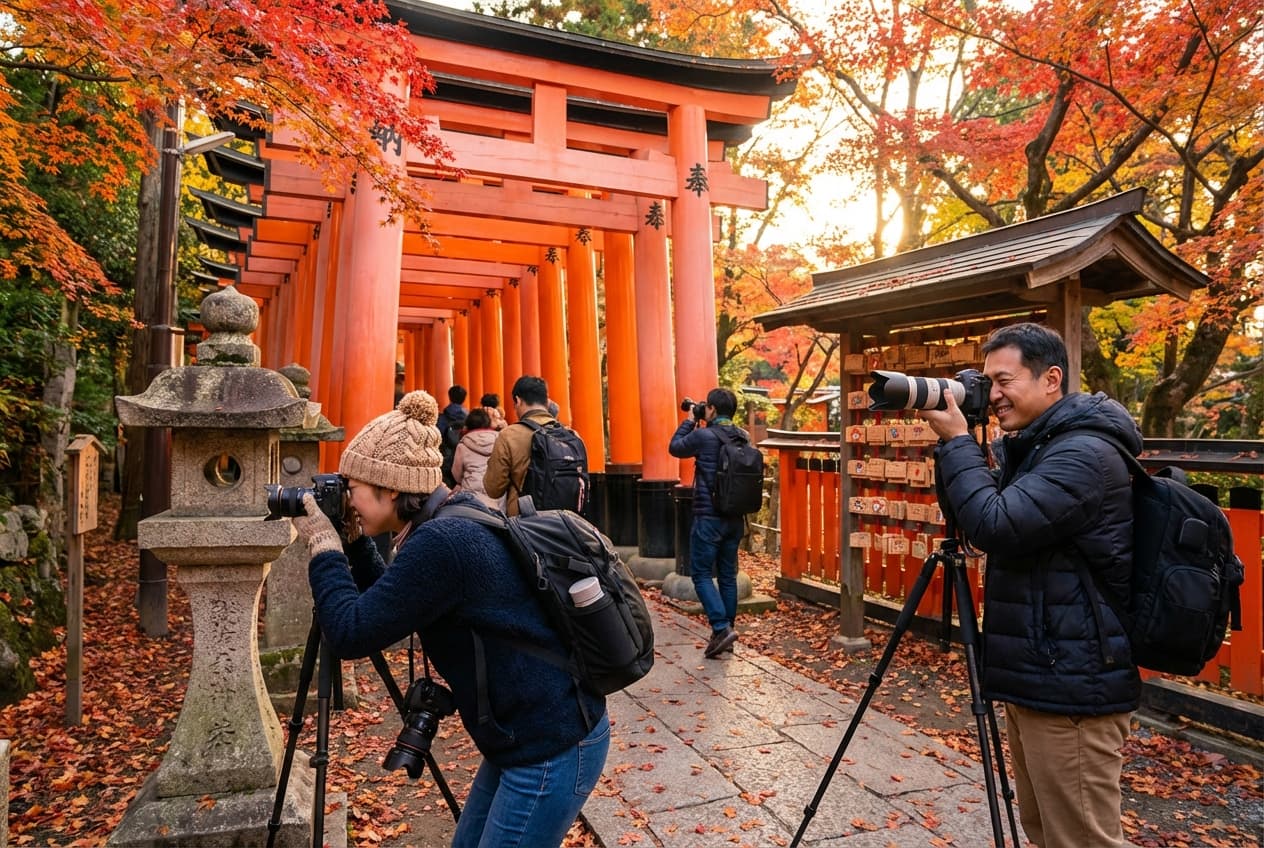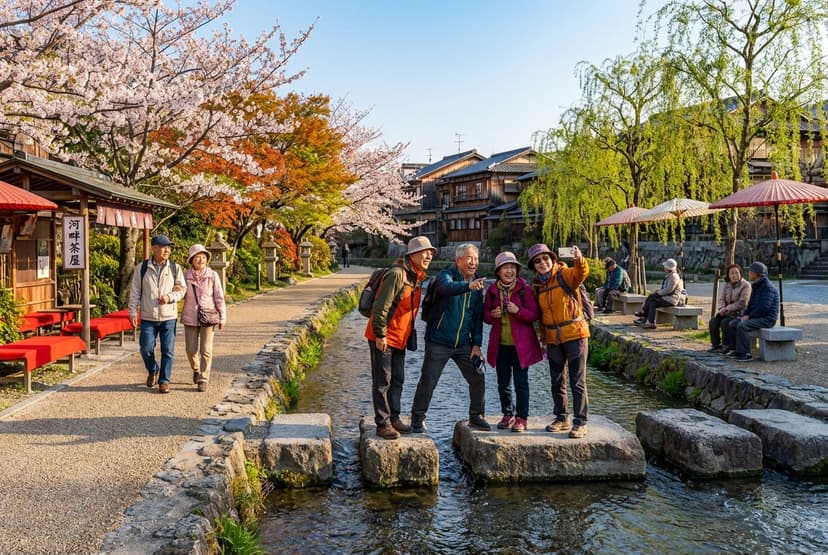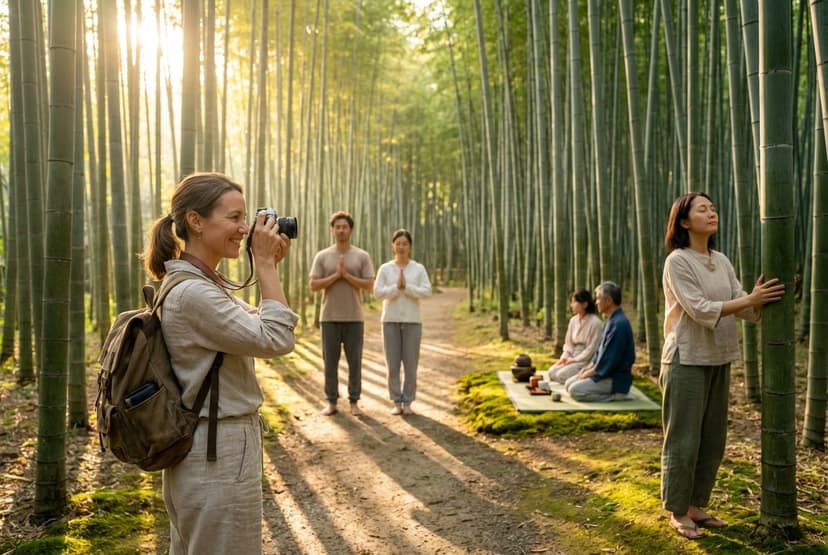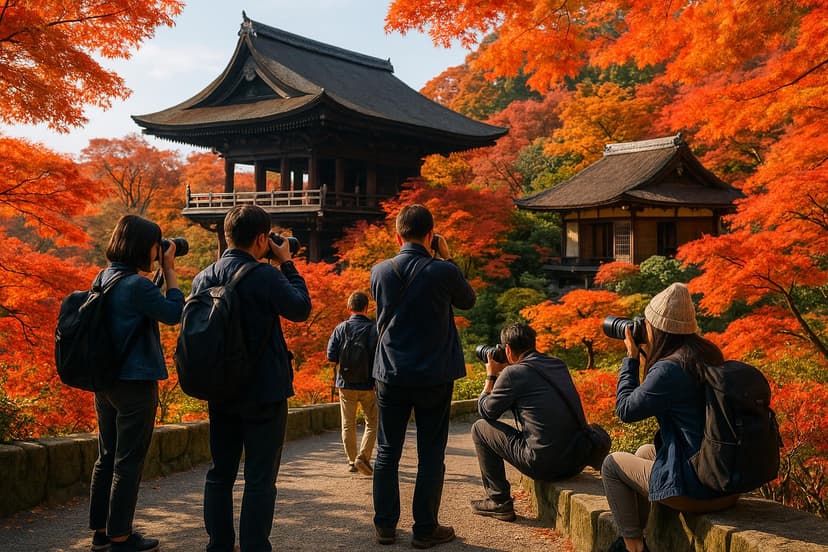Momiji Frames: Golden Hours from Arashiyama to Fushimi Inari

A 4-day, moody and cinematic photo itinerary through Kyoto's best autumn (momiji) frames. Tailored for photographers: sunrise and sunset golden-hour windows, iconic vistas and hidden vantage points, permit/gear notes, and flexible pacing to catch changing light and unexpected compositions.
Highlights
- Arashiyama Bamboo Grove at first light
- Okochi Sanso panoramic gardens with autumn color
- Kinkaku-ji & Ryoan-ji textured zen compositions
- Philosopher's Path and Ginkaku-ji golden-hour reflections
- Kiyomizu-dera evening skyline and Eikan-do nocturnal illumination
- Fushimi Inari Torii sequence at sunrise and Fushimi sake district
Itinerary
Day 1
Arashiyama dawn light, riverside compositions, and hillside vantage points — a full day to explore bamboo, temples, and quieter backstreets before the crowds.
Sagano / Arashiyama Bamboo Grove — first light walk
Walk the bamboo aisles during the first light to capture vertical textures and the soft warm morning glow before tour groups arrive.
Tips from local experts:
- Arrive at least 30–45 minutes before official sunrise to get streak-free, low-crowd lanes; handheld wide-angle (16–35mm) and a fast prime are ideal.
- Tripods are often contested here — use a compact travel tripod and be ready to step aside; for long exposures use early pre-dawn when foot traffic is minimal.
- No commercial filming permit (for paid shoots) is granted on the path without temple/city permission — contact Kyoto city for pro shoots; personal stills are fine but be mindful of blocking paths.
Togetsukyo Bridge — river & mountain silhouette
Short walk to the bridge for river reflections and mountain-framed compositions as the sun rises behind the hills.
Tips from local experts:
- Position yourself on the riverbank facing upstream for mirrored reflections; a polarizer helps manage glare on the water.
- Golden hour is brief in November — plan lens changes in advance (24–70 for versatility) and scout side vantage points for bamboo + bridge overlaps.
- Crowds build quickly; if you want an empty bridge look for side vantage points just east of the bridge on the embankment.
Breakfast & light break — % ARABICA Arashiyama (coffee & quick prep)
Caffeine and quick battery/memory-card check near the station; small cafe perfect for scouting next shots and warming up.
Tips from local experts:
- Use this stop to change batteries and wipe lenses — cold mornings drain batteries faster in November.
- If you need quick scout photos, the cafe's outdoor seating faces the river with nice bokeh opportunities; avoid tripod blocking the walkway.
- Order something portable so you can continue shooting on foot if light conditions change.
Okochi Sanso Garden — curated gardens & panoramic frames
A private villa garden with terraces, teahouses, and sweeping views of Kyoto’s hills — one of the best controlled-composition spots for autumn hues (entrance fee applies).
Tips from local experts:
- Arrive mid-morning for soft side light on maple leaves; wide-angle and short-tele lenses both work — bring a 35mm and 85mm for compositional variety.
- There is an entrance fee; staff monitor tripods — be discrete and avoid blocking pathways; commercial shoots require prior permission.
- Look for layered compositions combining stone lanterns, moss, and bright maples for cinematic foreground interest.
Tenryu-ji Temple Garden — zen composition and mossy textures
Explore the temple's garden for framed maple reflections and classic Japanese garden composition; close to Okochi Sanso so easy to sequence.
Tips from local experts:
- The pond offers symmetrical reflections — aim for calm moments and consider a neutral-density filter if you want silky water with people moving through the frame.
- Tripods are usually allowed inside the outer garden but avoid blocking pathways; lenses 24–70 and 70–200 are useful for varied framing.
- Temple gardens are maintained carefully—use the built-in elements (stone, bridges) for leading lines and intimate detail shots of leaves and textures.
Lunch — Shoraian (tofu kaiseki by the river)
A quieter, locally loved tofu restaurant with gentle river views — a measured, photogenic lunch that complements the day's tones.
Tips from local experts:
- Reserve in advance for a window table; the soft interiors offer good color contrast to the outdoor foliage for intimate table-top shots.
- The food is delicate — shoot with natural window light and a 50mm or 85mm for shallow-depth food portraits.
- Allow at least an hour here to rest and review morning captures; Kyoto's late-afternoon light decisions are often made over lunch.
Saga-Toriimoto Preserved Street — quiet backstreets & momiji details
Historic lanes that retain an older Kyoto feeling — ideal for moody street details, doorways framed by red maple, and bicycle silhouettes.
Tips from local experts:
- Look for shallow-depth portraits of locals and craftsmen with maple bokeh — use a 35mm or 50mm at f/2–f/4.
- The area has uneven footpaths; be mindful of low light under eaves—steady handheld ISO increases are preferable to tripod obstruction.
- Ask permission before close-up portraits of shopfronts or owners; many will be accommodating if you show prints on-camera.
Iwatayama Monkey Park — hillside panorama for late golden hour
A short hike rewards you with panoramic views over Kyoto and forested slopes turning red — dramatic silhouette shots at the sun's low angle.
Tips from local experts:
- The trail is a 20–30 minute climb from the trailhead; plan arrival so you're at the summit ~45 minutes before sunset for color transitions.
- Keep a telephoto (70–200mm) for safe monkey portraiture; do not feed or approach wildlife and secure gear against curious animals.
- The park closes close to dusk — check exact closing times in November and aim to descend before dark; carry a headlamp if staying afterward.
Day 2
Northern temples and the Philosopher's Path — textured zen gardens, raked rock patterns, and reflective canal light as afternoons deepen.
Kinkaku-ji (Golden Pavilion) — morning reflections
Arrive early for classic mirrored shots of the pavilion with autumn colors framing the foreground.
Tips from local experts:
- Golden pavilion is busiest midday; aim for the opening to capture cleaner reflections with fewer people and softer light from the east.
- A polarizer can strengthen reflection contrast; wide-angle to standard zooms (24–70mm) will cover both pavilion and foliage.
- Commercial shoots require prior permission from temple management; personal photography is allowed but mind designated walkways.
Ryoan-ji Rock Garden — minimalism and texture
Study the interplay of raked gravel, moss, and maple framing for minimal, contemplative compositions.
Tips from local experts:
- The rock garden rewards patience — shoot from the official viewing terrace with a medium telephoto (85–135mm) to compress texture layers.
- Avoid tripods on the terrace if officials are present; handheld high-ISO exposures are preferable to blocking visitor flow.
- Look for side-framing maples and mossy stones — tight details make excellent portfolio contrasts to the broader pavilion shots.
Lunch & downtime — Okutan Nanzenji (yudofu tradition)
A traditional tofu lunch near Nanzen-ji to rest and prepare for the afternoon's quieter temple approaches.
Tips from local experts:
- Yudofu dishes photograph best in soft window light—use a 50mm lens and keep white balance warm to match wooden interiors.
- Take this time to cull early-morning shots and plan Philosopher's Path sequences; a laptop or tablet helps for quick edits.
- Reserve if possible; November lunchtime near temples fills quickly and delays can eat into golden-hour windows.
Ninna-ji Temple (Omuro-style) — intimate maple clusters
Explore the compound for small, photogenic pockets of colored leaves, pagodas and quiet courtyards away from larger crowds.
Tips from local experts:
- Ninna-ji's trees are lower and ideal for layered foregrounds — shoot at lower angles to mix pagoda silhouettes with leaves.
- Use a tilt toward longer focal lengths to isolate color clusters and compress the temple lines into cinematic bands.
- Check for entrance times and any guide restrictions in November; some sections may have seasonal illumination policies.
Philosopher's Path & Ginkaku-ji (late afternoon to golden hour)
Walk the canal-side Philosopher's Path with reflections and then frame Ginkaku-ji's refined gardens in the soft, warm late light.
Tips from local experts:
- Late afternoon produces beautiful side-light along the canal—use a mid-range zoom (35–70mm) and consider stitched panoramas to capture the path.
- Ginkaku-ji's garden offers layered reflections; be mindful of tripod rules and use remote release or 2s timer to avoid shake.
- If crowds rise, continue north along the path to find quieter turns and small bridges that offer cleaner lines and bokeh.
Day 3
Higashiyama's alleys and temple lights — food textures, cobbled streets, sunset at Kiyomizu and a possible nocturnal illumination at Eikan‑do.
Nishiki Market — morning food photography and textures
Capture bustling food stalls, saturated colors, and close-up textures — perfect for detail portraits and shallow-depth shots.
Tips from local experts:
- Use a 35mm or 50mm for environmental food portraits; shoot at eye level for human-interest frames and low angles for vendor counters.
- Many stalls allow quick photos—ask politely before photographing staff or close-up food plating.
- Market opens mid-morning; for calmer scenes arrive early (market stalls begin setup around 9:00) to avoid peak tourist traffic.
Pontocho Alley and Kamogawa riverside — midday mood & alley light
Moody alleyways and riverside compositions; aim for graphic neon/window reflections for cinematic contrast.
Tips from local experts:
- Use a small aperture (f/4–f/8) for alley detail and depth, or wide-open for narrow bokeh on window lights; ISO will likely need bumping indoors.
- Pontocho is narrow and busy—avoid tripods in the alley and prefer fast primes to freeze motion or capture low light.
- Scout riverside steps for silhouettes at golden hour; they become especially cinematic with passing riverside traffic and willow framing.
Lunch break — riverside izakaya (flexible local choice)
Relaxed meal and gear check; choose a riverside spot to keep an eye on afternoon light and plan the Kiyomizu approach.
Tips from local experts:
- Keep a light kit at the table—switch to a fast prime for evening street work and store bulky gear in a safe bag.
- Try seasonal dishes (crab, persimmon in November) for color contrast and macro food shots.
- Allow a 60–75 minute window to avoid eating into the late-afternoon golden hour.
Sannen-zaka & Ninen-zaka — cobbled streets and traditional shopfronts
Wander these iconic lanes for moody street portraits, shop-front details, and layered compositions with maples overhead.
Tips from local experts:
- Use a 35mm for environmental portraits and a 85mm to compress layers of shopfronts and color bands.
- Be mindful of busy foot traffic — shoot during off-peak late afternoon for cleaner frames or behind a doorway for foreground framing.
- Respect local businesses; ask before using intrusive lighting or staging portrait shoots in front of doorways.
Kiyomizu-dera — golden-hour city vista and temple deck
The temple's main viewing deck offers sweeping skyline frames — late afternoon warmth accentuates autumn colors across the city valley.
Tips from local experts:
- Arrive 1 hour before sunset to pick a deck spot and compose both wide cityscapes and intimate leaf-lined frames; expect a modest entrance fee.
- Tripods may be restricted on the main deck during busy hours; use high-ISO settings or a monopod, or compose from neighboring side paths for tripod use.
- Commercial shoots need prior permission from the temple administration; personal photography is common but be discreet with lighting stands.
Eikan-do (Zenrin-ji) evening illumination — nocturnal color and reflection (seasonal)
If November illumination is scheduled, Eikan-do offers dramatic night scenes of lit maples and reflective ponds — a unique moody finale.
Tips from local experts:
- Night illuminations require separate admission and sell out on key dates—buy tickets in advance if available and arrive early to claim tripod-friendly positions.
- Use a sturdy tripod and cable release; expect longer exposures (10–30s) and experiment with bracketed exposures to manage high contrast.
- Bring a rain cover and microfiber cloth—night shoots in November can be damp or dewy and lenses fog easily when moving between warm/ cold areas.
Day 4
Final day focused on Fushimi Inari at first light and the Fushimi sake district — torii sequences, intimate shrine details, and mellow afternoon sake warehouse portraits.
Fushimi Inari Taisha — summit torii sequence at sunrise
Beat the crowds with a pre-dawn climb through the torii tunnels to capture layered orange gates with soft morning light and breathe-taking low-angle compositions.
Tips from local experts:
- Start hiking well before official sunrise (around 05:00–05:30 in November) to catch empty torii tunnels and cool-blue pre-dawn tones transitioning to warm light.
- Tripods are allowed but the path is busy—compact tripod and polite placement are essential; telephoto lenses (85–200mm) isolate repeating torii, wide angle for immersive sequences.
- Fushimi Inari is open 24/7 and free—there is no entrance fee, but note that commercial shoots require shrine office permission for large setups.
Breakfast near Inari & rest — JR Inari Station area
Slow breakfast and buffer time after the hike; quick gear maintenance and card swaps before heading to the sake district.
Tips from local experts:
- Use this time to offload images to a backup drive or cloud — the morning yields many frames and it's safer to secure them before moving on.
- Warm up with a local teahouse or café—capture the quiet station details for street contrasts with the torii shots.
- Allow time for a short rest; the Fushimi area involves relaxed walking but some brewery tasting rooms have limited hours.
Gekkeikan Okura Sake Museum & Fushimi Sake District walk
Document old kura (sake storehouses), cedar casks, and mellow amber interiors — great for texture shots and intimate story sequences.
Tips from local experts:
- Museum interiors are dim—bring a fast prime (35mm or 50mm) and consider higher ISO; low shutter speeds are fine if you use a compact tripod where allowed.
- Many buildings allow interior photos but avoid flash; ask permission if you want to shoot behind-the-scenes or staff at work.
- Tasting sampling (if you participate) can add story frames—capture close-ups of pouring, labels, and wooden barrels for authentic editorial sequences.
Lunch — Sake district meal (local tavern or brewery eatery)
Lunch in the area using local seasonal ingredients — pair with sake for atmospheric indoor shots.
Tips from local experts:
- Choose a low-lit tavern for moody interior food and bottle shots — a 35mm at f/1.8 works well for table scenes.
- Photograph label details and wooden crates to add texture to your reportage set; ask proprietors about their favorites for authentic plating.
- Reserve or arrive early; weekend afternoons in November can be busier with domestic leaf-watchers visiting the sake district.
Fushimi local lanes & quiet shrine backstreets — late afternoon scouting
Seek low-traffic alleys, small shrines and resident gardens that reflect the day's tonal palette — an unhurried afternoon for creative exploration.
Tips from local experts:
- Use this flexible window to revisit any shots you loved earlier in different light — pack a 24–70 and a tele for variety.
- Local residents may be out in late afternoon—candid documentary portraits work best when you ask consent; small printed photo cards make great icebreakers.
- Keep spare batteries and a lens cloth handy; river-proximate lanes can be misty in cool November afternoons.
Final golden hour wrap — choose between a last riverside shot or return to torii for backlit gates
Flexible final golden hour: either riverside reflections along the Uji-Fushimi stretch or a return to a quieter torii approach for backlit gate silhouettes.
Tips from local experts:
- Decide midday based on weather — if it's clear, prioritize torii backlight for dramatic rim light; if overcast, the river yields saturated reflections.
- Late-weekdays are typically quieter; prioritize revisiting any location where light was fickle earlier in the trip.
- For commercial/edited sequences, note that any staged portrait work in shrine precincts often requires shrine permission — plan ahead if you need controlled lighting setups.







